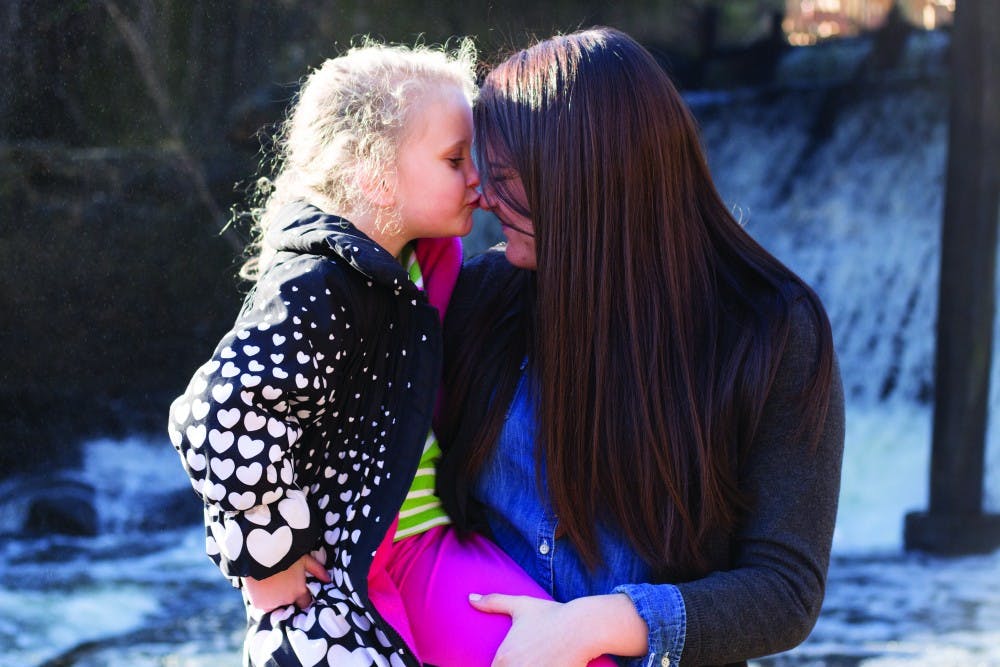Madison Bourne was getting ready to get back in the classroom in August 2011, months after she dropped out of classes at the University of South Carolina, at the urging of her then-boyfriend. She registered for general education classes at Midlands Technical College with the intention of eventually getting back to USC. But two weeks before her first class, a little pink plus sign changed everything.
Bourne was pregnant at 19 years old, but she didn’t put her plans on hold. She took classes at Midlands Tech during the fall semester and moved to online classes during the spring, finishing a few weeks early, just in time for a 22-hour natural birth. Her daughter Rowan, now almost 3, was born in April 2012.
Bourne balanced motherhood with online classes for the first year of Rowan’s life, with support from her family but not Rowan’s father.
“I broke up with him as soon as I found out I was pregnant,” Bourne says. “I figured if he was a terrible boyfriend, he would be a terrible father. He’s the one who wanted me to drop out of school in the first place.”
After a year of balancing books and baby at home, Bourne felt ready to return to USC.
But Bourne’s story is not typical of young mothers. Unplanned pregnancy among teenagers and young women is often a barrier to pursuing or continuing education; 61 percent of community college students who have children after they enroll do not complete their education, according to the National Campaign to Prevent Teen and Unplanned Pregnancy. Unplanned births cause nearly one in 10 dropouts by community college students and 7 percent of all community college dropouts. It’s difficult to find similar research on four-year college students.
While teen pregnancy may elicit the image of a 16-year-old girl preparing for motherhood, two thirds of South Carolina’s teen pregnancies occur among women aged 18 and 19, like Bourne. The highest percentage of unplanned pregnancies occur among women aged 18 to 24, the ages many women are in college.
Colleges are not designed to cater to young parents. USC has some resources, including daycare available at its Child Development Center and nursing mother’s lounges around campus, but the only information specifically applicable to students in the university’s “Healthy Baby and You” pamphlet is about health insurance. Student parents pay the same weekly or daily fees at the Child Development Center that any other parent would, ranging from $98 per child for multiple children over the age of 5 to $211 for each child under 2 years old. If Rowan attended day care at the Child Development Center, Bourne would pay between $188 and $194 per week, instead of around $130 per week, which she pays at an off-campus facility.
The pressures of unplanned pregnancy and parenthood can become major obstacles in the pursuit of a degree. Studies show that many young mothers lack even a high school diploma and attribute their pregnancy and parenthood as the reason. Young mothers who stay in school share their peers’ worries about exams and campus parking, but on top of the financial and personal responsibilities of parenthood.
Those stressors were no different for Bourne. Faced with motherhood, she had to learn to strike a balance between school and her daughter, and it wasn’t easy.
“I was very unhappy when I had her. I didn’t think I could go back to school, but she was my little inspiration,” Bourne says. “Everything I do, I’m doing for her.”
A big help was easing back into education while at home with Rowan for 18 months, Bourne says. They lived with Bourne’s mother and stepfather as Bourne completed general education classes online. Support from her family is “the only reason I’m still sane,” she says.
“A lot of people are not as lucky as I’ve been,” Bourne says. “I have an amazing support system.”
But when she returned to campus, bringing 18-month-old Rowan with her, Bourne had to deal with others who were not as supportive. She felt stares and strange looks from passersby when she played with Rowan on campus, and felt silent judgment from classmates when her first day of class “fun fact” was that she had a daughter.
“I feel the most judgment from other non-parents,” Bourne says. “People wonder, ‘Why do you have a bookbag and a baby?’”
Now that Rowan attends daycare when Bourne is in class, one would not likely guess Bourne is a mother upon meeting her. She seems like an average 22-year-old college student, going to class and work. Her time on campus is her time to do the “normal” stuff: study in the library, work in the University Housing office and maybe even get a few minutes to relax. Once she gets home, she’s in mom mode.
“When I go home, I don’t study. I don’t have time,” Bourne says. “The moment I want to sit down and do something is the moment she wants to play.”
Now, after dropping out, dropping back in and having a baby, Bourne is in her final semester of school. In May, she’ll graduate with a degree in women’s and gender studies and business, and she hopes to work at a bank. Rowan is growing up, too; she’s a little blonde-haired, blue-eyed lightning strike of a personality who “likes to sing along with Anna and Elsa from ‘Frozen,’ and then make Anna and Elsa fight in the dirt.”
Bourne says although she expected it to get harder, it’s become easier as Rowan has gotten older. The two have gotten into their own routine, and Rowan has gotten a little more independent — she even sometimes commandeers her mother’s phone to watch her favorite music videos — and Bourne sees their future as bright.
“I think I’m doing awesome. We have encouraged her to be the best toddler she can be,” Bourne says. “But she’s taught me more than I’ve taught her.”
*Models portrayed in this spread are not Bourne and her daughter, or an actual mother-daughter pair.



